Abstract
Decreased accumulation of the fluorescent dye BCECF [2', 7'-bis-(2-carboxyethyl)-5-(6)- carboxyfluorescein] characterized murine and human multidrug-resistant cell lines overexpressing the multidrug resistance protein (MRP). Indomethacin (10 microM), a known cyclo-oxygenase and glutathione-S-transferase inhibitor as well as a modulator of anion transport, increased accumulation and blocked efflux of BCECF in MRP-expressing murine and human cells. The drug did not affect P-glycoprotein (P-gp)-mediated export of rhodamine 123. The indomethacin effect on BCECF efflux was not reversed by the addition of exogenous prostaglandins, suggesting that the drug acts by a mechanism other than decreasing prostaglandin synthesis. Indomethacin also increased multidrug susceptibility of both murine and human cell lines overexpressing MRP, but not those displaying P-gp-associated resistance. In addition, indomethacin modulated the decreased vincristine accumulation in cells expressing MRP, but not in those expressing P-gp. These data suggest that indomethacin is a specific inhibitor of MRP, possibly functioning by inhibition of glutathione-S-transferase or, alternatively, by direct competition with the drug at the transport site.
Full text
PDF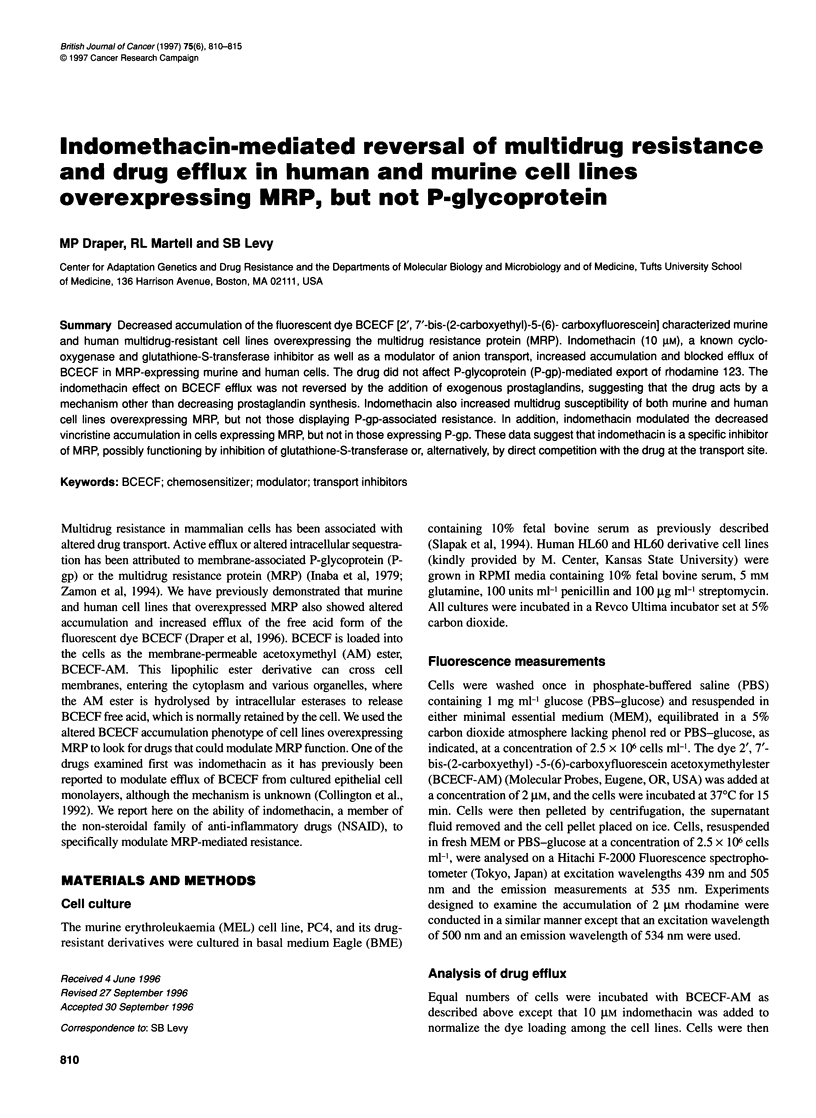
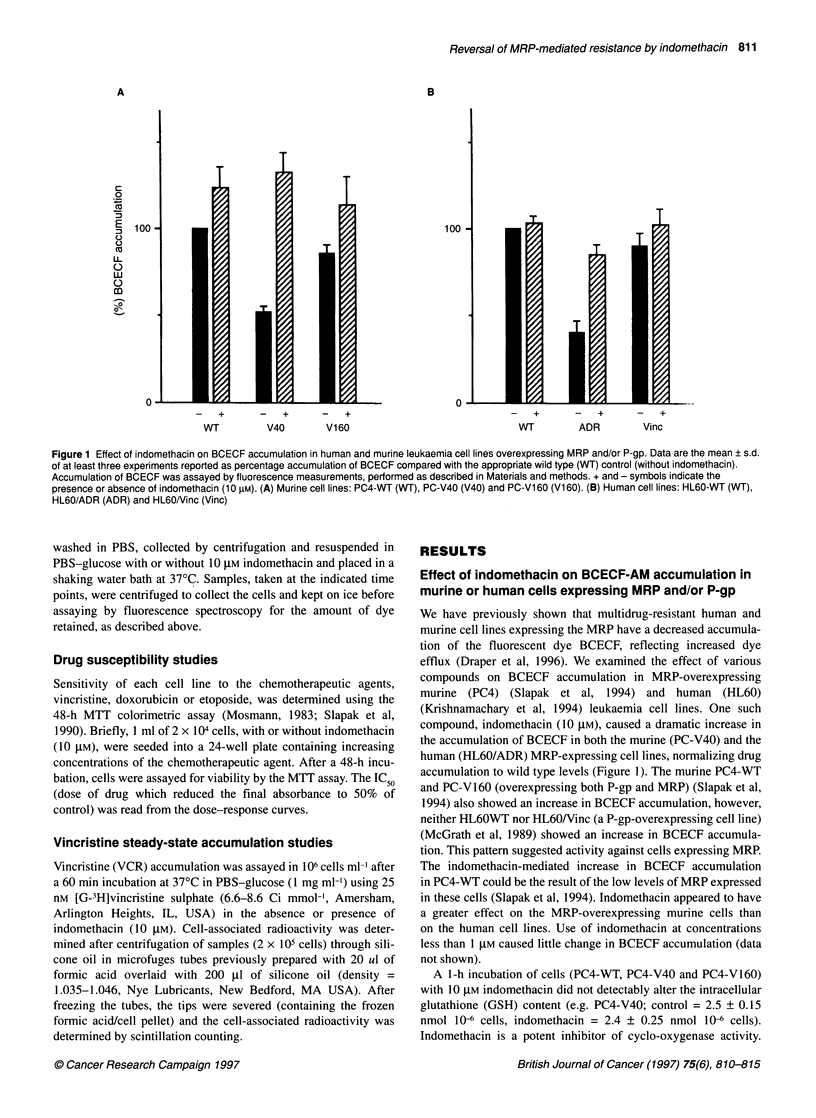
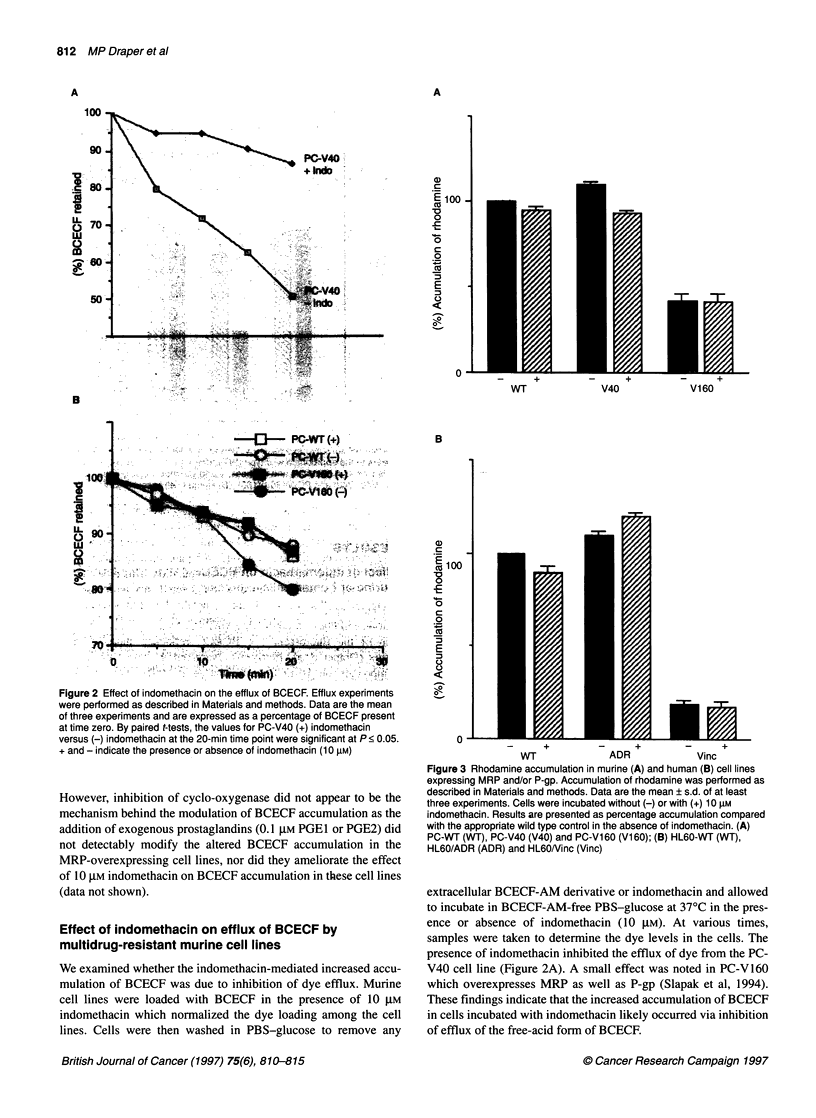
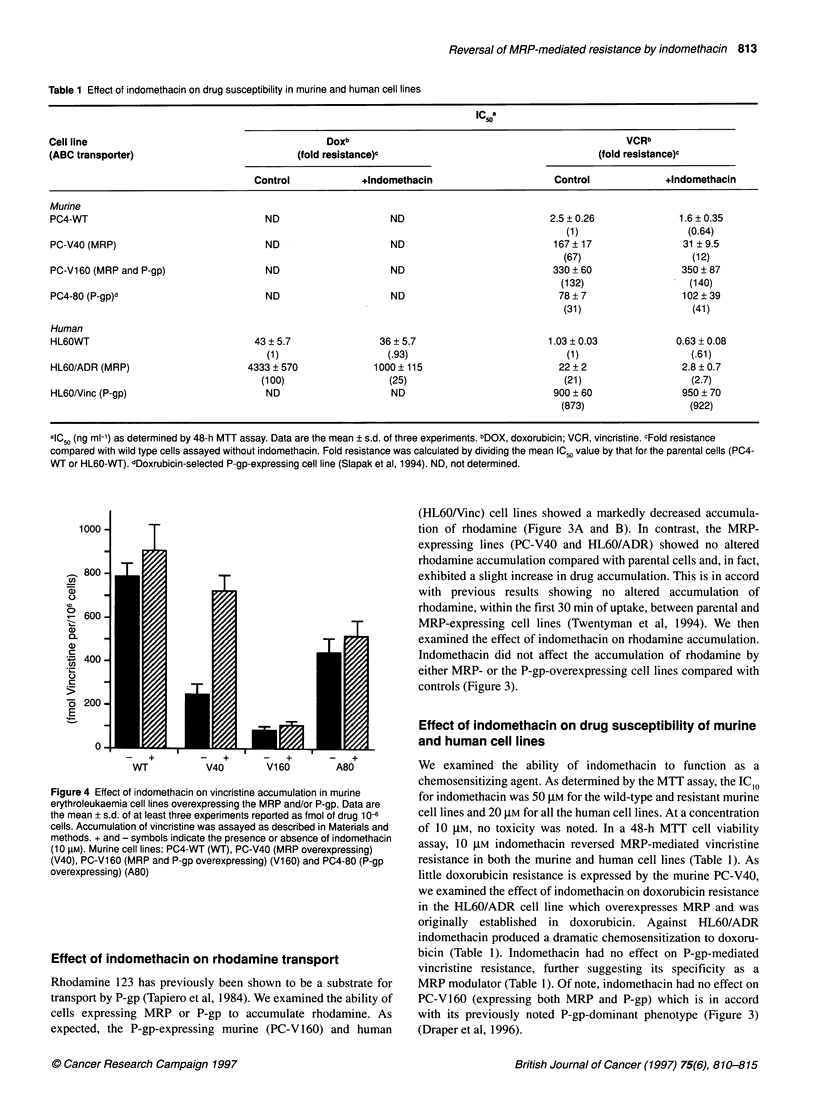
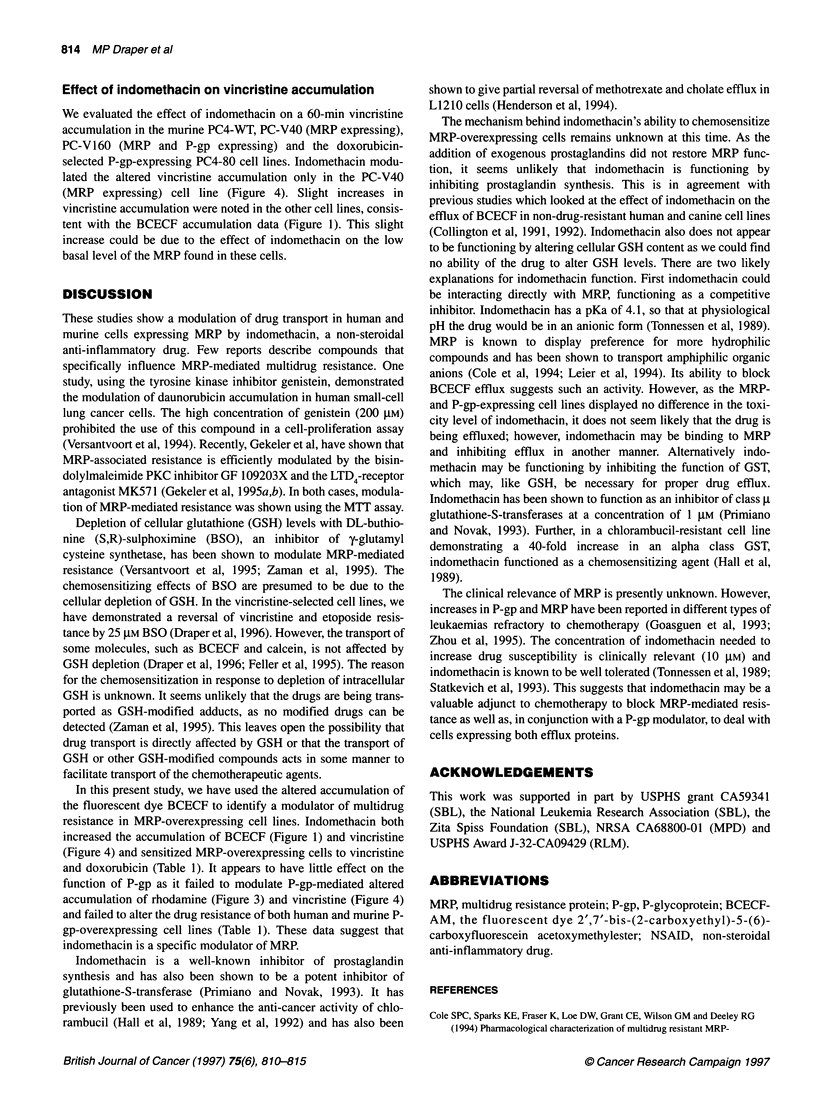
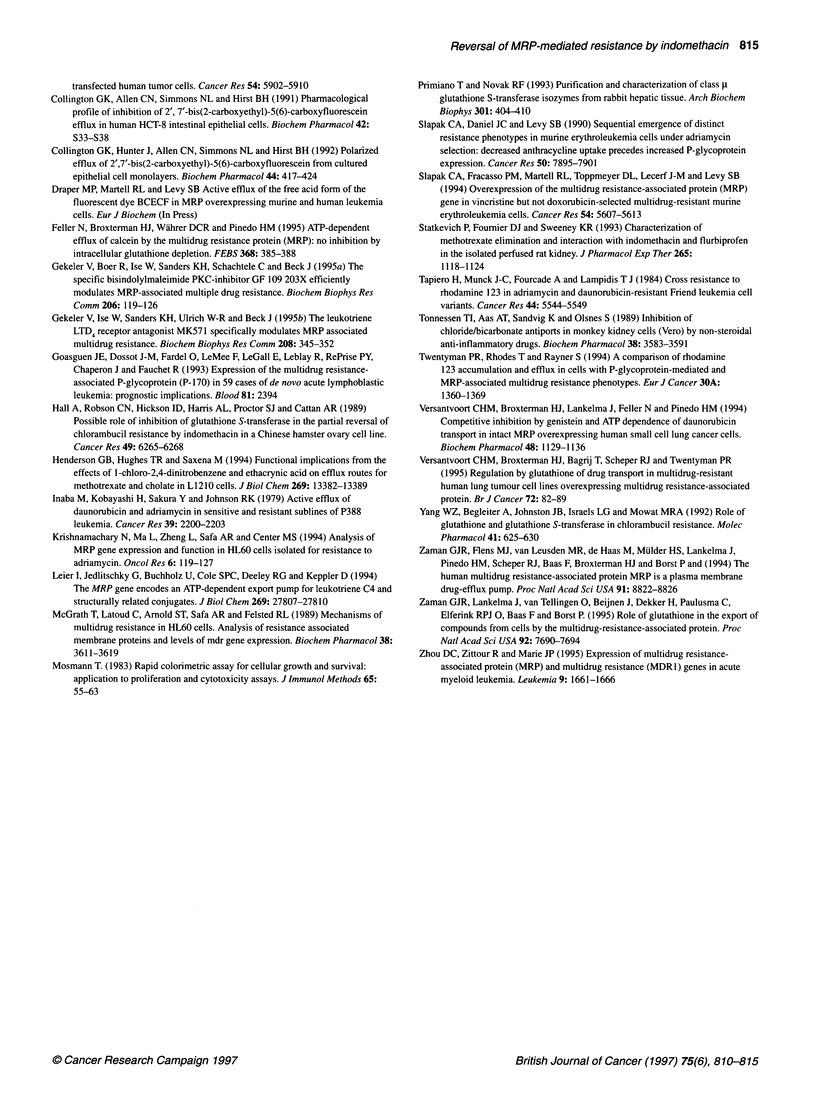
Selected References
These references are in PubMed. This may not be the complete list of references from this article.
- Cole S. P., Sparks K. E., Fraser K., Loe D. W., Grant C. E., Wilson G. M., Deeley R. G. Pharmacological characterization of multidrug resistant MRP-transfected human tumor cells. Cancer Res. 1994 Nov 15;54(22):5902–5910. [PubMed] [Google Scholar]
- Collington G. K., Allen C. N., Simmons N. L., Hirst B. H. Pharmacological profile of inhibition of 2',7'-bis(2-carboxyethyl)-5(6)-carboxyfluorescein efflux in human HCT-8 intestinal epithelial cells. Biochem Pharmacol. 1991 Dec 11;42 (Suppl):S33–S38. doi: 10.1016/0006-2952(91)90389-m. [DOI] [PubMed] [Google Scholar]
- Collington G. K., Hunter J., Allen C. N., Simmons N. L., Hirst B. H. Polarized efflux of 2',7'-bis(2-carboxyethyl)-5(6)-carboxyfluorescein from cultured epithelial cell monolayers. Biochem Pharmacol. 1992 Aug 4;44(3):417–424. doi: 10.1016/0006-2952(92)90431-h. [DOI] [PubMed] [Google Scholar]
- Feller N., Broxterman H. J., Währer D. C., Pinedo H. M. ATP-dependent efflux of calcein by the multidrug resistance protein (MRP): no inhibition by intracellular glutathione depletion. FEBS Lett. 1995 Jul 17;368(2):385–388. doi: 10.1016/0014-5793(95)00677-2. [DOI] [PubMed] [Google Scholar]
- Gekeler V., Boer R., Ise W., Sanders K. H., Schächtele C., Beck J. The specific bisindolylmaleimide PKC-inhibitor GF 109203X efficiently modulates MRP-associated multiple drug resistance. Biochem Biophys Res Commun. 1995 Jan 5;206(1):119–126. doi: 10.1006/bbrc.1995.1017. [DOI] [PubMed] [Google Scholar]
- Gekeler V., Ise W., Sanders K. H., Ulrich W. R., Beck J. The leukotriene LTD4 receptor antagonist MK571 specifically modulates MRP associated multidrug resistance. Biochem Biophys Res Commun. 1995 Mar 8;208(1):345–352. doi: 10.1006/bbrc.1995.1344. [DOI] [PubMed] [Google Scholar]
- Goasguen J. E., Dossot J. M., Fardel O., Le Mee F., Le Gall E., Leblay R., LePrise P. Y., Chaperon J., Fauchet R. Expression of the multidrug resistance-associated P-glycoprotein (P-170) in 59 cases of de novo acute lymphoblastic leukemia: prognostic implications. Blood. 1993 May 1;81(9):2394–2398. [PubMed] [Google Scholar]
- Hall A., Robson C. N., Hickson I. D., Harris A. L., Proctor S. J., Cattan A. R. Possible role of inhibition of glutathione S-transferase in the partial reversal of chlorambucil resistance by indomethacin in a Chinese hamster ovary cell line. Cancer Res. 1989 Nov 15;49(22):6265–6268. [PubMed] [Google Scholar]
- Henderson G. B., Hughes T. R., Saxena M. Functional implications from the effects of 1-chloro-2,4-dinitrobenzene and ethacrynic acid on efflux routes for methotrexate and cholate in L1210 cells. J Biol Chem. 1994 May 6;269(18):13382–13389. [PubMed] [Google Scholar]
- Inaba M., Kobayashi H., Sakurai Y., Johnson R. K. Active efflux of daunorubicin and adriamycin in sensitive and resistant sublines of P388 leukemia. Cancer Res. 1979 Jun;39(6 Pt 1):2200–2203. [PubMed] [Google Scholar]
- Krishnamachary N., Ma L., Zheng L., Safa A. R., Center M. S. Analysis of MRP gene expression and function in HL60 cells isolated for resistance to adriamycin. Oncol Res. 1994;6(3):119–127. [PubMed] [Google Scholar]
- Leier I., Jedlitschky G., Buchholz U., Cole S. P., Deeley R. G., Keppler D. The MRP gene encodes an ATP-dependent export pump for leukotriene C4 and structurally related conjugates. J Biol Chem. 1994 Nov 11;269(45):27807–27810. [PubMed] [Google Scholar]
- McGrath T., Latoud C., Arnold S. T., Safa A. R., Felsted R. L., Center M. S. Mechanisms of multidrug resistance in HL60 cells. Analysis of resistance associated membrane proteins and levels of mdr gene expression. Biochem Pharmacol. 1989 Oct 15;38(20):3611–3619. doi: 10.1016/0006-2952(89)90134-2. [DOI] [PubMed] [Google Scholar]
- Mosmann T. Rapid colorimetric assay for cellular growth and survival: application to proliferation and cytotoxicity assays. J Immunol Methods. 1983 Dec 16;65(1-2):55–63. doi: 10.1016/0022-1759(83)90303-4. [DOI] [PubMed] [Google Scholar]
- Primiano T., Novak R. F. Purification and characterization of class mu glutathione S-transferase isozymes from rabbit hepatic tissue. Arch Biochem Biophys. 1993 Mar;301(2):404–410. doi: 10.1006/abbi.1993.1163. [DOI] [PubMed] [Google Scholar]
- Slapak C. A., Daniel J. C., Levy S. B. Sequential emergence of distinct resistance phenotypes in murine erythroleukemia cells under adriamycin selection: decreased anthracycline uptake precedes increased P-glycoprotein expression. Cancer Res. 1990 Dec 15;50(24):7895–7901. [PubMed] [Google Scholar]
- Slapak C. A., Fracasso P. M., Martell R. L., Toppmeyer D. L., Lecerf J. M., Levy S. B. Overexpression of the multidrug resistance-associated protein (MRP) gene in vincristine but not doxorubicin-selected multidrug-resistant murine erythroleukemia cells. Cancer Res. 1994 Nov 1;54(21):5607–5613. [PubMed] [Google Scholar]
- Statkevich P., Fournier D. J., Sweeney K. R. Characterization of methotrexate elimination and interaction with indomethacin and flurbiprofen in the isolated perfused rat kidney. J Pharmacol Exp Ther. 1993 Jun;265(3):1118–1124. [PubMed] [Google Scholar]
- Tapiero H., Munck J. N., Fourcade A., Lampidis T. J. Cross-resistance to rhodamine 123 in Adriamycin- and daunorubicin-resistant Friend leukemia cell variants. Cancer Res. 1984 Dec;44(12 Pt 1):5544–5549. [PubMed] [Google Scholar]
- Twentyman P. R., Rhodes T., Rayner S. A comparison of rhodamine 123 accumulation and efflux in cells with P-glycoprotein-mediated and MRP-associated multidrug resistance phenotypes. Eur J Cancer. 1994;30A(9):1360–1369. doi: 10.1016/0959-8049(94)90187-2. [DOI] [PubMed] [Google Scholar]
- Tønnessen T. I., Aas A. T., Sandvig K., Olsnes S. Inhibition of chloride/bicarbonate antiports in monkey kidney cells (Vero) by non-steroidal anti-inflammatory drugs. Biochem Pharmacol. 1989 Oct 15;38(20):3583–3591. doi: 10.1016/0006-2952(89)90131-7. [DOI] [PubMed] [Google Scholar]
- Versantvoort C. H., Broxterman H. J., Bagrij T., Scheper R. J., Twentyman P. R. Regulation by glutathione of drug transport in multidrug-resistant human lung tumour cell lines overexpressing multidrug resistance-associated protein. Br J Cancer. 1995 Jul;72(1):82–89. doi: 10.1038/bjc.1995.281. [DOI] [PMC free article] [PubMed] [Google Scholar]
- Versantvoort C. H., Broxterman H. J., Lankelma J., Feller N., Pinedo H. M. Competitive inhibition by genistein and ATP dependence of daunorubicin transport in intact MRP overexpressing human small cell lung cancer cells. Biochem Pharmacol. 1994 Sep 15;48(6):1129–1136. doi: 10.1016/0006-2952(94)90149-x. [DOI] [PubMed] [Google Scholar]
- Yang W. Z., Begleiter A., Johnston J. B., Israels L. G., Mowat M. R. Role of glutathione and glutathione S-transferase in chlorambucil resistance. Mol Pharmacol. 1992 Apr;41(4):625–630. [PubMed] [Google Scholar]
- Zaman G. J., Flens M. J., van Leusden M. R., de Haas M., Mülder H. S., Lankelma J., Pinedo H. M., Scheper R. J., Baas F., Broxterman H. J. The human multidrug resistance-associated protein MRP is a plasma membrane drug-efflux pump. Proc Natl Acad Sci U S A. 1994 Sep 13;91(19):8822–8826. doi: 10.1073/pnas.91.19.8822. [DOI] [PMC free article] [PubMed] [Google Scholar]
- Zaman G. J., Lankelma J., van Tellingen O., Beijnen J., Dekker H., Paulusma C., Oude Elferink R. P., Baas F., Borst P. Role of glutathione in the export of compounds from cells by the multidrug-resistance-associated protein. Proc Natl Acad Sci U S A. 1995 Aug 15;92(17):7690–7694. doi: 10.1073/pnas.92.17.7690. [DOI] [PMC free article] [PubMed] [Google Scholar]
- Zhou D. C., Zittoun R., Marie J. P. Expression of multidrug resistance-associated protein (MRP) and multidrug resistance (MDR1) genes in acute myeloid leukemia. Leukemia. 1995 Oct;9(10):1661–1666. [PubMed] [Google Scholar]


